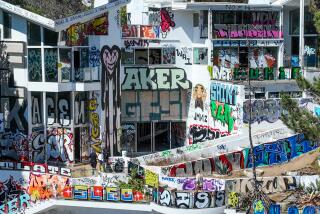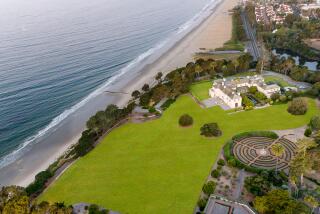A New Drill for the Lavish Home of an Oil Tycoon
- Share via
For a hundred years it’s been among the most mysterious places in Los Angeles.
Petroleum deals that made its owner one of America’s richest men -- and ensnared him in one of the nation’s biggest political scandals --were played out behind its thick walls.
Kings and cardinals and tycoons were invited inside for balls and elegant dinners that were said to rival those at the White House. But nearly everybody else, even kids trick-or-treating at Halloween, was barred from setting foot anywhere near it.
The Doheny Mansion was off limits.
But now the Catholic women’s school that has owned the landmark for 40 years is opening it for public tours that are intended to become a regular feature.
Docents recruited and trained by Mount St. Mary’s College staged a tour test run in April at the estate, built in an eclectic blend of Gothic, Mission and French styles. Their next set of guided tours is planned for July 12, with others scheduled for Oct. 11 and Jan. 24.
College leaders have carefully guarded the home and original 1898 furnishings. They hope that restoring some of the mansion’s public mystique will generate momentum -- and cash -- for its continued upkeep.
“Attitudes change. Sometimes you’re very protective when you’re conserving something,” said MaryAnn Bonino, the mansion’s curator. “We want to raise the consciousness of the public about what is here.”
The college, whose main campus is in Brentwood, obtained 8 Chester Place north of USC after Estelle Doheny died in 1958. She had willed it to the Catholic Archdiocese of Los Angeles for educational purposes.
She was the widow of Edward Doheny, who in 1893 drilled the city’s first oil well and later became rich from petroleum production in the San Joaquin Valley and Mexico.
But she hated the mansion when her husband bought it for her in 1901.
He was living in a converted Pullman rail car that he traveled in during oil exploration trips when he married her after a three-month courtship. She had been a long-distance operator who often put his business phone calls through for him. He had been smitten by her voice.
After they wed, Doheny needed a larger place, and he needed it fast. He bought the 10,500-square-foot mansion near Figueroa Street and West Adams Boulevard from a mining company executive. It came fully furnished and ready to move into.
Author Margaret Leslie Davis recounted in her 1998 biography of Doheny, “Dark Side of Fortune,” how Estelle pleaded with her new husband to “only rent” the mansion until something more pleasing could be found.
“She pointed out that the interiors were extremely dark, the halls narrow and the windows few. She begged Doheny to consider other sites,” telling him, “ ‘I was heartsick when I saw the inside of that house,’ ” wrote Davis.
The oilman couldn’t be persuaded, however. He paid the then-extravagant price of $120,000 for it -- in cash -- and told his wife to fix up the 22-room house to her liking.
Estelle wasted no time. She brightened up the place by chopping down large shade trees outside. Then she launched a series of remodeling projects that would continue for decades.
She started out by doing what generations of Los Angeles homeowners have done: She enclosed the back patio.
But this was no do-it-yourself project. Louis Comfort Tiffany was commissioned to design a 40-foot dome of shell-shaped favrile glass for the new room. The rotunda itself was encircled by carefully detailed stained-glass skylights.
Marble was imported from Italy, Spain and Africa for a mosaic floor inspired by Michelangelo’s Piazza del Campidoglio in Rome. More marble was used for 11 gleaming support columns. Walls were accented in gold leaf and by carved medallions.
The bright and airy Pompeian room, whose glass dome seemed to change colors during the day, became the mansion’s focal point in 1906 and the setting for fancy dinners.
Guests sat at mirror-topped tables so they could gaze at the glories above them without having to crane their necks, according to Don Sloper, a retired computer engineer from Palos Verdes Estates who heads the mansion’s docent group.
Part of the mansion’s third floor was turned into a ballroom in 1909. It was converted into a private chapel and an elevator was added in the 1920s as the Dohenys got older.
When the 1933 Long Beach earthquake heavily damaged the house, the Dohenys strengthened it with steel beams hidden in the marble columns.
As the mansion grew in fame and was featured in magazine and newspaper articles, Estelle Doheny became alarmed when strangers showed up to gawk, says biographer Davis. So her husband began buying up all of the houses on the block to make it a secure, gate-guarded street. He rented the dwellings to friends and business associates.
These days the seven surviving homes are used by Mount St. Mary’s students. The college has offices on the second floor of the Doheny Mansion. The third floor is a residence for nuns such as Sister Aline Marie, who has lived there 38 years.
The college holds receptions on the first floor, and the Da Camera Society’s Chamber Music in Historic Sites series has presented concerts there for 30 years.
Former Mount St. Mary’s professor Mary Sloper, who has helped her husband organize the docents, said much of the first-floor furniture, carpeting and artwork is original.
“Look at this picture of Mrs. Doheny reading and talking on the phone. The couch and table and lamp in the background are the same,” she said, displaying an electric light-box photograph of Estelle taken in the 1950s in the Great Hall living room. The photo also shows the circa-1860s “Five Senses” painting, which still hangs in the same place above the couch, table and lamp.
Tours will include the Great Hall, dining room, reception room, music room, library, office and billiard room/art gallery as well as the Pompeian room and outside areas. The cost is $25 per person; reservations for the next tour must be booked at (213) 477-2761 by Monday.
Not on display will be Edward Doheny’s papers and journals detailing his success in launching oil production in Los Angeles and Mexico. Also missing will be court documents relating to federal charges filed against him in the Teapot Dome scandal.
That episode, named for a teapot-shaped rock formation at an oil field, caused a national furor in the 1920s. Authorities alleged that Doheny paid a $100,000 bribe to the head of the U.S. Department of the Interior for petroleum rights to the Elk Hills oil reserves in Kern County. Doheny was acquitted in the case, even though Interior Secretary Albert Fall was convicted and sent to prison.
Estelle destroyed all her husband’s papers within hours of his funeral in 1935, taking them from the home’s safes and stuffing them into the incinerator.
Why she did so is one of those Doheny Mansion mysteries.
More to Read
Sign up for Essential California
The most important California stories and recommendations in your inbox every morning.
You may occasionally receive promotional content from the Los Angeles Times.














